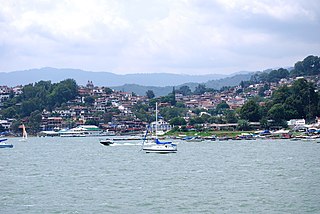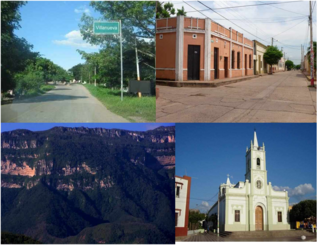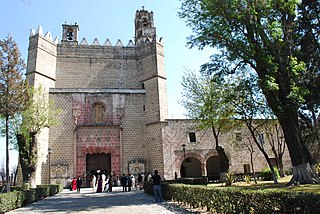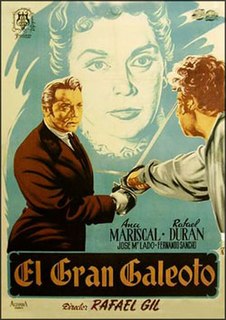
Arbor Day is a secular day of observance in which individuals and groups are encouraged to plant trees. Today, many countries observe such a holiday. Though usually observed in the spring, the date varies, depending on climate and suitable planting season.

San Lorenzo de El Escorial, also known as El Escorial de Arriba, is a town and municipality in the Community of Madrid, Spain, located to the northwest of the region in the southeastern side of the Sierra de Guadarrama, at the foot of Mount Abantos and Las Machotas, 47 kilometres (29 mi) from Madrid. It is head of the eponymous judicial party. The settlement is popularly called El Escorial de Arriba, to differentiate it from the neighbouring village of El Escorial, also known as El Escorial de Abajo.

Amecameca is a municipality located in the eastern panhandle of Mexico State between Mexico City and the Iztaccíhuatl and Popocatépetl volcanos of the Sierra Nevada mountain range. It is located on federal highway 115 which leads to Cuautla, which is called the Volcano Route.

Puebla, officially Free and Sovereign State of Puebla, is one of the 32 states which comprise the Federal Entities of Mexico. It is divided into 217 municipalities and its capital is the city of Puebla.

Valledupar is a city and municipality in northeastern Colombia. It is the capital of Cesar Department. Its name, Valle de Upar, was established in honor of the Amerindian cacique who ruled the valley; Cacique Upar. The city lies between the mountains of Sierra Nevada de Santa Marta and the Serranía del Perijá to the borders of the Guatapurí and Cesar rivers.

Valle de Bravo is one of 125 municipalities in State of Mexico, Mexico. The largest town and municipal seat is the town of Valle de Bravo. It is located on the shore of Lake Avándaro, approximately 156 km southwest of Mexico City and west of Toluca on highways 15, 134 or 1. It takes about two hours to drive from Mexico City to Valle de Bravo, making it a popular weekend getaway for the capital's affluent upper class.

Iriga, officially known as the City of Iriga, is a 4th class component city in the province of Camarines Sur, Philippines. According to the 2020 census, it has a population of 114,457 people.

Villarrobledo is a Spanish city and municipality in the province of Albacete, part of the autonomous community of Castile-La Mancha. It's better known for having the world's largest area covered by vineyards as well as the world's greatest production of La Mancha wine, called in Spanish Denominación de Origen. Also, it is an important center of Manchego cheese production and export and has other important industries like metallurgy and transportation.

Villanueva de los Infantes is a municipality in the province of Ciudad Real, Castilla–La Mancha, Spain. It has a population of 5727 people.

Villanueva is a town and municipality located in the northern Department of La Guajira, Colombia. Villanueva is known in Colombia for being the cradle of many vallenato singers and composers. The economy of the town relies heavily on agriculture and farming.

Pé de Serra is a Brazilian municipality in the state of Bahia. It is located in Sisaleira region, Microregion of Serrinha. It was emancipated on March 20, 1985, and the population according to IBGE was 13,556 in 2020. The territorial area is 597 km2.

Duruelo de la Sierra is a municipality of Spain, in the province of Soria, Autonomous Community of Castile and León.

Villanueva del Fresno is a town in Badajoz Province in Extremadura, Spain.

Tepotzotlán is a city and a municipality in the Mexican state of Mexico. It is located 40 km (25 mi) northeast of Mexico City about a 45-minute drive along the Mexico City-Querétaro at marker number 41. In Aztec times, the area was the center of a dominion that negotiated to keep most of its independence in return with being allied with the Aztec Triple Alliance. Later, it would also be part of a "Republic of the Indians," allowing for some autonomy under Spanish rule as well. The town became a major educational center during the colonial period when the Jesuits established the College of San Francisco Javier. The college complex that grew from its beginnings in 1580 would remain an educational center until 1914. Today this complex houses the Museo del Virreinato, with one of the largest collections of art and other objects from this time period.

José María of Manila is a Spanish Filipino Roman Catholic blessed, and was priest of the Order of Friars Minor Capuchin. He was martyred in the early phase of the Spanish Civil War, and is the third Filipino to have been declared blessed by the Roman Catholic Church.

Huejotzingo (modern Nahuatl pronunciation is a small city and municipality located just northwest of the city of Puebla, in central Mexico. The settlement's history dates back to the pre-Hispanic period, when it was a dominion, with its capital a short distance from where the modern settlement is today. Modern Huejotzingo is located where a Franciscan monastery was founded in 1525, and in 1529, the monks moved the indigenous population of Huejotzingo to live around the monastery. Today, Huejotzingo is known for the production of alcoholic apple cider and fruit preserves, as well as its annual carnival. This carnival is distinct as it centers on the re-enactment of several historical and legendary events related to the area. The largest of these is related to the Battle of Puebla, with about 2, 000 residents representing French and Mexican forces that engage in mock battles over four days.
Navalvillar de Ibor is a municipality located in the province of Cáceres, in the autonomous community of Extremadura, Spain. The municipality covers an area of 54.5 square kilometres (21.0 sq mi) and as of 2011 had a population of 484 people.

Miguel Herrero Uceda is a writer, lecturer and natural scientist committed to the defence of the environment and the conservation of popular traditional culture. He has a PhD in artificial intelligence and was a professor at Universidad Complutense of Madrid. He is a promoter of the natural philosophy "arbotherapy", a therapy to combat the stress and the anxiety generated by modern world.

Elisa Herrero Uceda is a Spanish writer. She is committed to the defence of the environment and the conservation of folk culture. She has written articles and books on natural and folk culture.

The Great Galeoto is a 1951 Spanish drama film directed by Rafael Gil and starring Ana Mariscal and Rafael Durán.





















